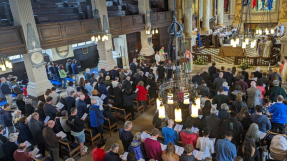
A set of five short songs in the Gospel of Luke are known as the Christmas Canticles, and have contributed greatly to Christian worship over the centuries. This is the story...
The Christmas Canticles
Luke's account of the Nativity in the first two chapters of his Gospel account includes five songs which have been used over the centuries for Christian worship and liturgy. It is in Luke that we find the song of Mary, known as the Magnificat; the song of Zechariah, known as the Benedictus; the song of the angels, known as the Gloria; and the song of Simeon, known as the Nunc Dimittis.
These are sometimes called the Christmas Canticles, or sometimes the Evangelical Canticles, because they are found in the Gospel (or Evangelium in Latin) of St. Luke. The word canticle derives from the Latin word "canticulum", meaning little song. These canticles have been chanted or sung in liturgy through most of Church history and across the Christian world. In most modern translations of the Bible, they are lain out as poetry. Although originally in Greek, they are actually better known in Latin.
The Magnificat
The first canticle in Luke is known as the Magnificat and is found at Luke 1:46-55. The name Magnificat comes from its first line in Latin "Magnificat anima mea Dominum" meaning "My soul doth magnify the Lord" (Luke 1:46 KJV). The canticle appears in the Nativity chronology, when Mary goes to spend three months with Elizabeth, before Jesus is born. The Magnificat is a poem of praise to God, and is the longest sequence of words spoken by any woman in the New Testament. It is in the style of Old Testament canticles, and is the first one in the New Testament. Actually, there was some debate about whether the song is attributed to Mary, or whether it was spoken by Elizabeth. Depending on the manuscript which it is translated from, the Magnificat follows the phrase "And Mary said:" or "And Elizabeth said:". The NRSV acknowledges this with a footnote attached to the name Mary, which reads "and other ancient authorities read Elizabeth".
Some scholars wonder if it originally read "And she said", and scribes added in the name according to their understanding. The words make sense for either. However, most people ascribe it to Mary, and the Magnificat is known as the Song of Mary, or the Canticle of Mary, or in the Orthodox world the Ode of the Theotokos.
The canticle echoes several Hebrew biblical passages. The strongest allusion is to the Song of Hannah (1 Samuel 2:1-10), an Old Testament canticle. In many ways the stories of Elizabeth and Mary have parallels with the story of Hannah, who had a miracle firstborn son who was dedicated at the Temple to a lifetime of service.
For some readers the Magnificat is also revolutionary, and almost a manifesto for liberation theology. In it, the proud are humbled and the humble exalted. Her lines read, "He has performed mighty deeds with his arm; he has scattered those who are proud in their inmost thoughts. He has brought down rulers from their thrones but has lifted up the humble. He has filled the hungry with good things but has sent the rich away empty" (Luke 1:51-53).
In the liturgy a doxology is added to the end of the Magnificat, called the Gloria Patri which goes "Glory be to the Father, and to the Son: and to the Holy Ghost; As it was in the beginning, is now, and ever shall be: world without end. Amen." This is not found in the original, but is part of the liturgical tradition. In some churches, the Magnificat is chanted every Sunday, and it is part of the Anglican Book of Common Prayer.
It has been set to music many times including by Bach and Mozart. A modern classic hymn, which is a form of the Magnificat, is "Tell out my Soul" by Timothy Dudley-Smith written in 1961, based on the text in the New English Bible. An even more modern version is "My soul will magnify the Lord" by Keith Getty, Kristyn Getty and Stuart Townend.
The Benedictus
The second canticle in Luke is the Benedictus, which is found at Luke 1:68-79. It is also known as the Song of Zachariah, or the Canticle of Zachary. It appears in the Nativity chronology, 8 days after the birth of John the Baptist at his circumcision. The title comes from the opening lines in Latin, "Benedictus Dominus Deus Israel", which translates in the Authorized Version as "Blessed be the Lord God of Israel" (Luke 1:68).
The Benedictus was the song of thanksgiving from Zechariah the priest, father of John the Baptist. The first (verses 68–75) is a song of thanksgiving for the realisation of the Messianic hopes of the Jewish nation. The second part is addressed to his own son, which quotes Isaiah 40:3.
The Benedictus has been part of Christian worship since the sixth century, and is part of the Book of Common Prayer.
The Benedictus has been set to music many times. One haunting composition is the 'Benedictus' by Sir Karl Jenkins from his composition "The Armed Man". According to the British radio station Classic FM it is "surely one of the most beautiful pieces of choral music from the last 50 years".
Nunc Dimittis
The third canticle in Luke is the Nunc Dimittis, which is found at Luke 2:29-32. It appears in the Nativity chronology, 40 days after the birth of Jesus at the purification of Mary at the Temple. The title comes from the opening words in Latin, "Nunc dimittis servum tuum, Domine" which translates in the Authorized Version as "Now thou dost dismiss thy servant, O Lord" (Luke 2:29 KJV). It is also known as the Song of Simeon, or the Canticle of Simeon.
This song is only three verses long, but has many Old Testament allusions. For example, "For mine eyes have seen thy salvation" (Luke 2:30 KJV) alludes to Isaiah 52:10, and "Which thou hast prepared before the face of all people" (Luke 2:31 KJV) alludes to Psalm 98:2.
It has been part of Christian worship since the fourth century, and is part of the Anglican Book of Common Prayer.
The Nunc Dimittis has been set to music many times. In 1915, the composer Gustav Holst created a setting for Nunc Dimittis for choirs. A modern version was produced by Geoffrey Burgon in 1979. It may be remembered by some being played over the closing credits of episodes of the 1979 British BBC television series Tinker Tailor Soldier Spy.
The Gloria in Excelsis
The Gloria in Excelsis is found at Luke 2:14. It appears in the Nativity chronology as being sung by the angels at Bethlehem when they announced the birth of Jesus. The title comes from the opening words in Latin, "Gloria in excelsis Deo", meaning "Glory to God in the highest". It is also known as the Angelic Hymn, or the Hymn of the Angels, or just the Gloria.
It has been part of Christian worship since the fourth century, and is part of the Anglican Book of Common Prayer.
The Gloria has been set to music many times including by Bach, Beethoven, Dvořák, Haydn, Vivaldi and a rediscovered work by Handel.
The song "While Shepherds Watched their Flocks by Night" is a metrical rendering of Luke 2:8-14 by Nahum Tate in common metre. This first appeared in print as an appendix to the Brady and Tate Metrical Psalter in 1700. This ends with the Gloria. In the eighteenth century the fact that it was Scripture set to music, meant that it was the only Christmas hymn authorized to be sung by the Anglican Church.
At Christmas many people also sing the carol "Ding dong! Merrily on high", first published in 1924, which has the chorus "Gloria in excelsis Deo". In 1978 there was a Taizé version. In 1981, the Dublin band U2 released a single called Gloria, singing "Gloria, in te domine, Gloria, exultate, Gloria, gloria" in Latin.
The Canticles today
The songs of Mary, Zechariah, the angels, and Simeon, are known as the Christmas Canticles. They have continued to be used as rich songs of praise down through the ages. These Scriptural canticles remain important to liturgical worship in the Orthodox, Catholic, Lutheran and high Anglican traditions. Why not read them in Luke, and ask Spofity or Alexa to play some of the beautiful compositions of them?













